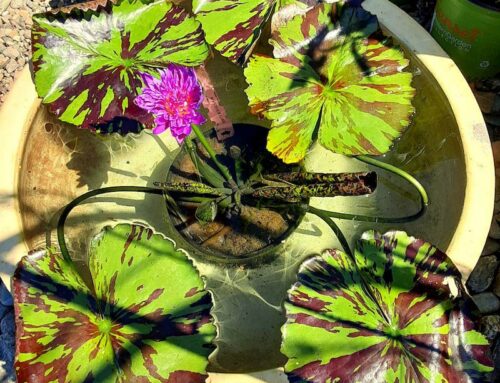As the temperatures drop and gardeners work on their annual winter clean-up, they should also allow some time and energy for putting their water gardens to bed for the winter. As with the regular garden, it is most important to clean up around all plants in the water and surrounding areas, removing dead leaves, stems and debris, so that it doesn’t fall to the bottom of the pond and create more debris. Cold-hardy water plants can be left to over-winter in the pond, while tropical water plants such as tropical water lilies should be taken out of the pond, cleaned up, and moved into a greenhouse or other sunny shelter, where temperatures don’t drop below 60 degrees. Plants already in containers can remain in their pots, and floating plants should be placed into pots of moist aquatic soil. Smaller floating plants can be placed in home aquariums until spring.
Avoid the temptation to turn off pond filters. Keeping the filter active not only helps keep the water clean, but will also keep the pond water from freezing. Placing a few blocks of wood in the water will also help keep water moving, thus avoiding ice build-up.
Fish naturally hibernate as water temperature drops. Keep a thermometer in the water, and when water temperatures drop down to 55 degrees, slow feeding to once a week with a cool season fish food with vitamins and minerals. Fish will hibernate at the bottom of the pond in cold water, stressing the importance of having the bottom of the pond as clean as possible.
If ice does form, it is best to spread a few inches of rock salt around the perimeter of the ice. The rock salt will help melt ice and will not hurt fish or vegetation. Don’t break up the ice, as it is very hard on the fish. If a hard frost threatens, winter-hardy plants should be placed in the deepest part of the pond, where they will probably sink to the bottom.
Fall is a good time to transplant all varieties of water plants using soil specially formulated for water gardens. Lotus plants should be divided at this time. As plants are dormant during the cold, fertilizing should be held off until spring. It is a good time however, to add Barley Straw Extract to pond water. This product gives off an enzyme which inhibits algae formation, and actually works better in colder weather.
The first signs of spring regeneration will be new growth on the Water Lilies. Fish will come to the surface as they get hungry. This is the time to once again begin cleaning up, repotting, and fertilizing your pond and its contents.
Cold Hardy Water Plants
- Arrowhead(Var.species)
- Saggitaria Latifolia
- Hardy Water Canna
- Thalia Dealbata
- Hardy Water Lily
- Nymphae
- Lotus
- Fabaceae
- Pickerel Weed
- Pontederia Cordata
- Umbrella Palm
- Papyrus
- Yellow or Blue Flag
- Iris Louisiana
Frost Sensitive Water Plants
- Sensitive Plant
- Egyptian Papyrus
- Taro
- Colocasia
- Tropical Water Lilies
- Nymphe
- Tropicana Canna
- Thalia Dealbata
- Water Hyacinth
- Eichhornia Crassipes
- Water Poppies
- Hydrocleys Nymphoides
More Winter Tips:
1. Clean your filter(s)
2. Vacuum the bottom of your pond; this is where your fish will hibernate for the winter.
3. Keep the filter systems ON, check daily for leaks due to ice jams if you live in colder areas.
4. Keep pond from freezing. Flowing water will not freeze if moving fast enough. Keep an open area in the pond, use a de-icier.
5. Thermometer, check often.
6. Protect your Pond/Water Garden with a Net to keep the leaves from falling to the bottom of the pond.
7. Keep an extra pump on hand, 500 or 1000 gph.
8. Keep a Journal, Count your fish and plan your next year’s pond.
And finally, please feel free to contact me at Wyntour Gardens if you have any questions.


